ISIS Redux: The Central Syria Insurgency in May 2021
Following is the May 2021 installment of “ISIS Redux: The Central Syria Insurgency,” a monthly chronicle of attacks by the terrorist group ISIS in central Syria. Previous editions of ISIS Redux can be viewed through the following links: April, March, February, and January 2021; December, November, October, September, August, July, June, May, and April 2020. A full background and analysis of ISIS’s resurgence in Syria, including its methodology, can also be explored here, here and here.
ISIS militants carried out at least 23 confirmed attacks in May, killing at least 29 pro-Assad regime fighters and two civilians, while wounding at least 73 in the Homs, Deir Ez Zor, Raqqa, Hama, and Aleppo governorates. The number of ISIS attacks carried out dropped significantly for the second month in a row, matching a level not seen since April 2020. Furthermore, ISIS cells only conducted five high quality* attacks during May, a level not witnessed since March 2020. The drop in ISIS activity in May, as in April, is largely due to the ongoing Syrian regime, Russian, and Iranian operations across Deir Ez Zor, Homs, and Raqqa.
ISIS continued to shift its focus away from civilians. All but three of May’s attacks as well as all high quality attacks targeted security forces. Despite the significant drop in the number of attacks, May’s attacks on average killed and wounded more people than those of the previous four months. More Assad regime security forces were killed in May than in March, despite ISIS conducting16 fewer attacks. However, in a sign of improved regime operations, May was the first in 17 months when ISIS failed to kill a regime commander.
ISIS cells relied on mines and improvised explosive devices (IED) for at least 10 of the 23 confirmed attacks in May, similar to April and March. Additional use of mines and IEDs by ISIS in Raqqa and Deir Ez Zor were referenced during interviews conducted by the author but were not recorded due to the lack of specificity about when they occurred. ISIS commonly reverts to a heavy reliance on indirect attacks when under heavy pressure from security forces, as has been the case for the past three months.
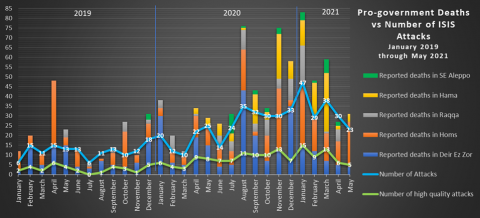
Attacks in May continued at roughly April’s pace in Homs (13), south Aleppo (1), and south Raqqa (1) while continuing their precipitous two month drop in Hama (4) and five-month drop in Deir Ez Zor (4). As in April, despite the overall drop in attacks on civilians, ISIS continued to heavily target them in eastern Hama. May was also the first month since March 2020 that only one governorate, in this case Homs, experienced high quality attacks.
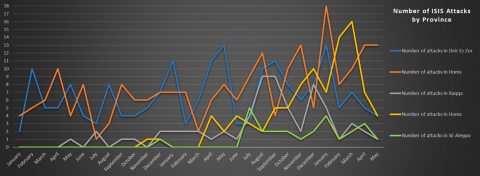
Hama
ISIS activity in east Hama dropped for the second month in a row, with only four documented attacks. Three of these attacks were mines hitting civilian vehicles and workers. The only significant documented attack occurred in northern Hama, west of Rahjan in an area that has seen a slowly expanding ISIS presence since the start of 2021. On May 9, ISIS fighters attacked a checkpoint near the village of Bayoud, killing one civilian and wounding a National Defense Forces (NDF) fighter. The attack was reported by locals and claimed by ISIS’s official media outlet Amaq, where the group stated its fighters overran the checkpoint and captured weapons.
In addition to these four documented attacks, the author was informed via interviews with local NDF members about additional, continued activity targeting shepherds. According to an NDF fighter previously deployed to the area and with extensive contacts in east Hama, ISIS cells have been stealing “hundreds” of sheep each week for at least the past two months. These robberies sometimes, but not always, involve the thieves killing shepherds. The sheep are then moved out of the governorate and eventually sold in other parts of the country, providing a lucrative financial stream for ISIS.
Homs
ISIS activity in Homs remained high in May, continuing the trend began in late April. ISIS conducted 13 attacks in Homs, at least six of which involved mines or IEDs. There was a noticeable expansion of activity outside of the usual core area of Sukhnah, largely due to Assad regime activity southeast of Palmyra and northeast of Sukhnah.
Five of the 13 attacks in Homs were high quality. On May 9, ISIS fighters ambushed and killed at least three members of the Liwa al-Quds’ Abu Zainab Group (a small militia formerly affiliated with the Tiger Forces) near Jabal Amor, north of Palmyra. On the same day elsewhere in the governorate, ISIS lured a regime convoy into a large IED ambush. According to a member of the regime’s 5th Corps interviewed by the author, a shepherd was killed by a mine, leading the locals to blame the army and demand they investigate. When the military convoy entered the area, they were hit with “every explosive device” including “standard mines, anti-armor mines, and homemade explosives.” At least one soldier was killed and 19 were wounded.
The next day, another series of mines killed six and wounded 20 soldiers in the Wadi Qatqat area northwest of Sukhnah. From approximately May 8 through May 13, ISIS and regime forces fought fierce battles east of Kawm, with at least four NDF fighters killed and 15 wounded as the regime attempted to push into the mountains. On May 15, ISIS released a statement claiming to have captured and executed five soldiers in eastern Homs “in recent days.”
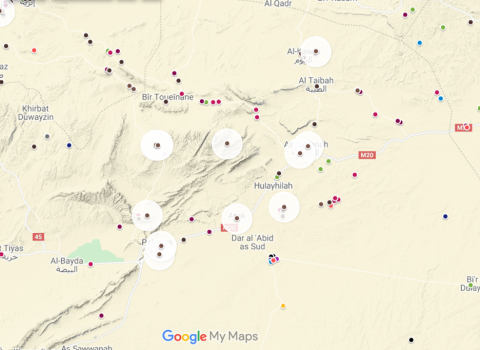
Map of ISIS attacks in Homs in May 2021 (highlighted dots). Not mapped are two additional attacks that combined killed six and wounded 19 soldiers somewhere in the Homs countryside.
Deir Ez Zor
Attacks in Deir Ez Zor dropped to their lowest level since July 2020 due to ongoing regime and Iranian operations in the desert. Most of the four attacks recorded in May appear to be from mines. The only attack of any significance was an attack on a checkpoint in Salhiyah, north of Bukamal, that killed two NDF fighters. However, the author was also told by knowledgeable regime sources that there had been additional, intermittent mine hits throughout the month. These were not recorded due to the lack of specificity about where and when these occurred.
Raqqa and Aleppo
Confirmed ISIS activity in south Raqqa and Aleppo continued to fluctuate in the one to three attacks per month range. Each governorate had one confirmed attack, both of note. On May 17, ISIS fighters ambushed a regime patrol near the Dubaysan Oil Field, destroying at least one vehicle. The patrol had been searching for five soldiers kidnapped by ISIS on April 20 and believed still alive and being held somewhere in the area. On May 20, ISIS claimed to attack a regime outpost in the Durayhim area of southern Aleppo. NDF sources confirmed the attack, saying three of their soldiers were wounded and none killed.
As in Deir Ez Zor, there were additional reports of attacks in these areas not included in the database. A regime 5th Corps fighter whose friends are currently deployed to Raqqa told the author that, like Deir Ez Zor, patrols were being hit by mines every couple of days. The fighter further stated that two opposition claims of ISIS attacks in the Maskanah region, on May 13 and May 18, had indeed occurred. However, other regime soldiers interviewed by the author could neither confirm nor deny the claims. These potential attacks should be noted, however, as ISIS and criminal activity in the Maskanah and Aleppo-Raqqa border areas is rising.
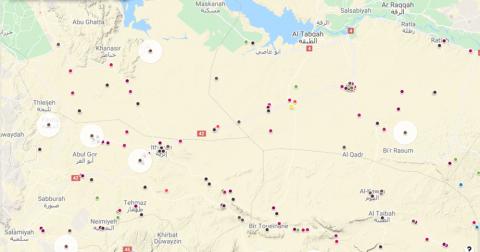
Map of ISIS attacks in Hama, Raqqa, and Aleppo in May 2021 (highlighted dots).
Regime Operations
Syrian regime anti-ISIS operations continued at a high pace in May and are increasingly being led by the Iranian-commanded Afghans of Liwa Fatemiyoun. As noted in previous updates, the regime launched its first true, large scale anti-ISIS operation in January of this year, targeting ISIS cells in Deir Ez Zor that had pushed south from Jabal Bishri and had successfully established themselves along the strategic Palmyra-Deir Ez Zor highway. This operation, commanded by the regime’s Major General Nizar Khader with combined forces from the Syrian Arab Army’s (SAA) 17th Division, 5th Corps, NDF, and Liwa Fatemiyoun, and supported by Russian aircraft, fought fierce battles with ISIS until about March 10. Then the active part of the operation ended, and the regime shifted to a strategy of flooding the newly cleared areas with fresh soldiers from the 5th Corps and 4th Division. Despite some minor clashes and mine attacks, the area north of Shoula has remained highly secure ever since.
In April, the Iranians launched a second set of smaller sweeps north of Shoula while shifting their focus south, beginning a new campaign in the Mayadin countryside under much secrecy. Unlike the Shoula campaign, this ongoing operation is being led by Iran and Liwa Fatemiyoun, but the foreign forces are still supported by the Deir Ez Zor NDF and SAA, and receive Syrian Air Force support. This Mayadin operation saw battles peak in late April, with reports of Afghan wounded and dead arriving at the Mayadin hospital. Since the start of May, however, the desert region of western Deir Ez Zor has been very quiet, with only the occasional mine hitting patrols as Liwa Fatemiyoun expands its presence.
Around the same time this Mayadin operation began in April, the regime started a new push to clear the Kawm Oasis region of northeast Homs. As stated in April’s ISIS update, this operation saw regime forces moving south from Resafa and north from Sukhnah, attempting to secure the string of oil and gas fields in this remote area. The ISIS-regime fighting around Kawm has historically been marked by its ping-pong nature, with neither side taking full control. However, the late April campaign appeared to yield more permanent progress for regime forces. Despite initial setbacks and after significant fighting, the regime had fully secured new positions about 5km east of the town by mid-May. Since then, regime forces have focused on securing and widening their new holdings, rather than attempting to push deeper into what they believe is an ISIS stronghold.
Elsewhere in Homs, Liwa Fatemiyoun has been assisting Syrian forces in sweeps east of Palmyra, particularly around Arak. Meanwhile patrols continue in southern Raqqa. The Syrian and Russian air forces continue to provide regular air support in Homs and Raqqa, reportedly arriving within 15 to 60 minutes of regime forces coming under attack. Of course, this leaves plenty of time for ISIS cells to quickly ambush or harass security forces without much consequence, and few if any insurgents have been killed in the bombing runs. Still, the constant threat of air support, combined with the extensive presence of ground forces, appears to have seriously hindered ISIS’s ability to operate in the Badia. The Russians are also pursuing an independent campaign in Deir Ez Zor of bombing suspected active and inactive ISIS hideouts in what appears to be a strategy of denying ISIS hiding places in the Badia. The impact of the campaign is not yet clear.
Looking Ahead
If the first three months of 2021 revealed a new willingness by Damascus to deal with ISIS in the Badia, the past two months have proven just how serious this decision was. Many analysts appear eager to view regime operations through stale, outdated frameworks rooted in earlier periods of the war. But with the frontlines frozen in the northwest, Damascus has plenty of manpower to devote to central Syria.
The Assad regime’s decision in April to follow up the successful Shoula operations with a large deployment of 4th Division troops to Homs and Deir Ez Zor, and then the unprecedented deployment of experienced 5th Corps battalions to Raqqa, demonstrates a shift in SAA tactical thinking. These operations should not be viewed as just another round of the same futile actions of the past three years, but as a serious shift in emphasis that is reaping benefits on the ground. The new strategy has forced ISIS to reduce its activity to levels not seen since Spring 2020, before the group’s massive expansion in the area. Crucially, ISIS has retained the ability to conduct occasional significant attacks on regime bases and convoys. But such actions have steadily been reduced from once a week to once a month, and they no longer have the same impact on regime operations as in the past.
The regime and Iranian operations of the past five months have been their most successful anti-ISIS campaigns since 2017 and have unquestionably forced ISIS onto the backfoot. The long-term success of these operations now relies on the regime maintaining its increased troop presence in the remote areas of Raqqa, Homs, and Deir Ez Zor, and on the Syrian and Russian air forces continuing to improve their support to ground troops. However, even if this happens, Damascus will still need to contend with the chaotic security environment in southeastern Aleppo and ISIS’s suspected financial operations in east Hama. Moreover, ISIS still operates training camps in the Badia, likely in southern Homs where the regime has yet to conduct major operations, and is maintaining its strength across the Euphrates in Syrian Democratic Forces (SDF)-held areas of Raqqa and Deir Ez Zor. ISIS’s strength on the eastern side of the river and the ease with which its fighters can cross between the two sides means that there is always the possibility that the group can shift resources west and increase its focus on regime positions.
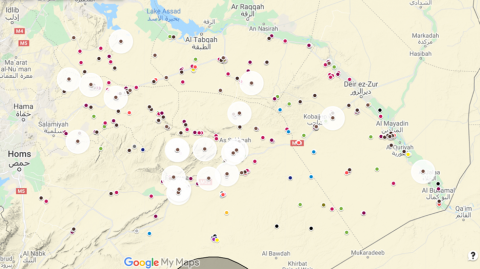
Map of locatable ISIS attacks (highlighted dots) in May 2021. This map does not include four attacks which did not have specific locations attributed to them: two “Homs countryside” attacks and two “Deir Ez Zor countryside” attacks. To view an interactive version of this map, please click here.
---
*High quality attacks are defined as attacks behind frontlines, those that result in seized positions, target regime officers, involve coordinated attacks on multiple positions, fake checkpoints, ambushes on military convoys, or attacks on checkpoints that kill at least three soldiers or lead to POWs.
Stay up to date on our latest news.
Get the latest news on extremism and counter-extremism delivered to your inbox.